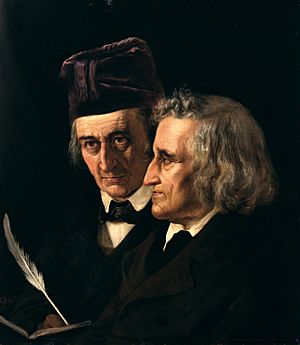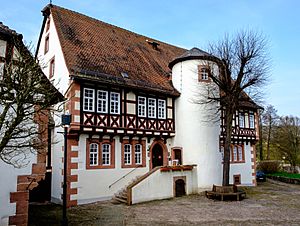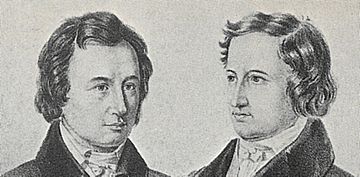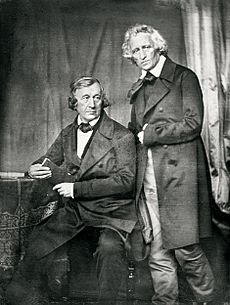Brothers Grimm facts for kids
The Brothers Grimm, Jacob (born 1785) and Wilhelm (born 1786), were German brothers who collected and published folklore. They are famous for popularizing many well-known fairy tales. These include "Cinderella", "The Frog Prince", "Hansel and Gretel", "Little Red Riding Hood", "Rapunzel", "Rumpelstiltskin", "Sleeping Beauty", and "Snow White". Their first collection of folk tales, Children's and Household Tales, was first published in 1812.
The Brothers Grimm grew up in Hanau, Germany. When their father died in 1796, the family became very poor. This hardship affected the brothers for many years. Both brothers studied at the University of Marburg. There, they became very interested in German folklore. This interest led them to spend their lives collecting German folk tales.
In the 1800s, there was a new interest in old folk stories. The Brothers Grimm saw these stories as a pure form of German culture. They created a way to collect and record folk stories. This method became the basis for folklore studies. Between 1812 and 1857, their first collection of tales was updated and republished many times. It grew from 86 stories to more than 200. Besides writing and changing folk tales, the brothers also wrote about Germanic and Scandinavian myths. In 1838, they started writing a huge German dictionary, which they could not finish in their lifetimes.
The Grimms' fairy tales are still very popular today. They are available in over 100 languages. Famous filmmakers like Walt Disney have adapted them into movies, such as Snow White and the Seven Dwarfs. In the mid-1900s, some groups used the tales for their own messages. Later, experts like Bruno Bettelheim confirmed the value of the stories. Even though some original versions were a bit harsh, the Grimms themselves made them gentler over time.
Contents
Biography
Early Lives
Jacob Ludwig Karl Grimm was born on January 4, 1785. Wilhelm Carl Grimm was born on February 24, 1786. They were born in Hanau, which is now part of Germany. Their father, Philipp Wilhelm Grimm, was a lawyer. Their mother, Dorothea Grimm, was the daughter of a city councilman. Jacob and Wilhelm were the second and third oldest of nine children. Sadly, three of their siblings died when they were babies. In 1791, their family moved to the town of Steinau. Their father worked there as a local official. The family became important members of the community. They lived in a large house surrounded by fields.
A writer named Jack Zipes said the brothers were happy in Steinau. They liked country life. The children were taught at home by private teachers. They were raised as Lutherans, which gave them strong religious faith. Later, they went to local schools.
In 1796, their father died from an illness. This made the large family very poor. Their mother had to let go of their servants and their big house. She relied on money from her father and sister. Jacob was the oldest living son. At age 11, he had to take on adult duties with Wilhelm. The brothers followed their grandfather's advice to always work hard.
In 1798, the brothers left Steinau and their family. They went to the Friedrichsgymnasium school in Kassel. Their aunt had arranged and paid for this. Since their grandfather had also died, they had no male provider. They had to rely completely on each other and became very close. Jacob was quiet, and Wilhelm was more outgoing, though he was often sick. But both worked very hard and did well in school. They noticed that students from richer families got more attention. Both brothers finished at the top of their class. Jacob graduated in 1803, and Wilhelm in 1804.
Kassel

After school, the brothers went to the University of Marburg. It was a small university with about 200 students. They found that students from lower social classes were not treated fairly. They were almost not allowed to study law because of their background. Richer students received money to help with costs, but the brothers did not. Their poverty kept them from student activities. However, being outsiders made them study even harder.
Their law professor, Friedrich Carl von Savigny, sparked their interest in history and philology (the study of language). They studied medieval German literature. They shared Savigny's dream of uniting the many German states into one country. Through Savigny's friends, the Grimms learned about Johann Gottfried Herder's ideas. Herder believed German literature should return to simpler forms, like folk poetry. The brothers loved their studies. Wilhelm wrote that studying Old German helped them overcome sadness.
In 1805, Jacob still had to support his mother and siblings. He took a job in Paris helping von Savigny. When he returned to Marburg, he had to stop his studies to support his family. They were so poor that food was often scarce. He took a job with the Hessian War Commission. Wilhelm wrote to his aunt, "We five people eat only three portions and only once a day."
Jacob found a full-time job in 1808. He became a librarian for the King of Westphalia. Later, he became a librarian in Kassel. After their mother died that year, Jacob was fully responsible for his younger siblings. He paid for his brother Ludwig to go to art school. He also paid for Wilhelm to visit Halle for health treatment. After that, Wilhelm joined Jacob as a librarian in Kassel. In 1807, the brothers had started collecting folk tales. At first, they were not sure how important this work would be.
Being librarians paid little, but it gave them lots of time for research. Between 1812 and 1830, they published many books. In 1812, they published their first book of 86 folk tales. Soon after, they published two books of German legends and a book on early literary history. They also published works about Danish and Irish folk tales. They kept editing their German folk tale collection. Their work became so well-known that they received special degrees from universities.
Göttingen
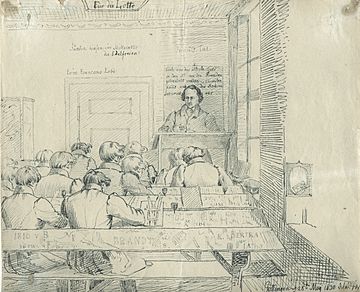
On May 15, 1825, Wilhelm married Henriette Dorothea (Dortchen) Wild. She was a childhood friend and had told the brothers several tales. Jacob never married. He continued to live with Wilhelm and Dortchen. In 1830, both brothers were passed over for a top librarian job. This made them very disappointed. They moved their household to Göttingen in the Kingdom of Hanover. There, they got jobs at the University of Göttingen. Jacob became a professor and head librarian, and Wilhelm became a professor.
For the next seven years, the brothers kept researching, writing, and publishing. In 1835, Jacob published his respected book German Mythology. Wilhelm continued to edit the third edition of Children's and Household Tales. Both brothers taught German studies at the university. They became well-known in this new field.
In 1837, the brothers lost their university jobs. They joined six other professors in a protest. The 1830s were a time of political change in Germany. The King of Hanover, Ernest Augustus, dissolved the parliament in 1837. He demanded loyalty oaths from government workers, including university professors. The seven professors refused to sign the oath. They were fired, and three were sent away from Hanover. Jacob was one of them and went to Kassel. Wilhelm, Dortchen, and their four children later joined him there.
The brothers had no income and faced money problems again in 1838. They started a huge project that would last their whole lives. This was writing a complete German dictionary, the German Dictionary. The first part was not published until 1854. Friends and supporters helped them with money and finding new jobs.
Berlin and Later Years
In 1840, friends helped the brothers get jobs at the University of Berlin. Besides teaching, the Academy of Sciences gave them money to continue their research. Once they settled in Berlin, they focused on the German dictionary. They also kept publishing their research. Jacob studied German legal traditions and the history of the German language. Wilhelm researched medieval literature and edited new editions of Children's and Household Tales.
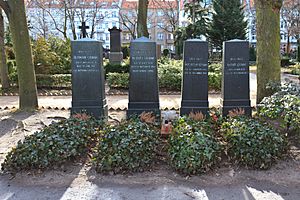
After the revolutions of 1848 in the German states, the brothers were elected to the parliament. Jacob became an important member of the National Assembly. But their political work did not last long. Their hope for a united Germany faded, and they became disappointed. In the late 1840s, Jacob left his university job. He published The History of the German Language. Wilhelm stayed at his university job until 1852. After retiring, the brothers spent the rest of their lives on the German Dictionary. Wilhelm died in Berlin on December 16, 1859. Jacob was very sad about his brother's death and became more withdrawn. He kept working on the dictionary until his own death on September 20, 1863.
Children's and Household Tales
Background

In the early 1800s, there was a new interest in fairy tales. The Grimms helped this interest grow with their collection of folklore. They believed that a country's true identity could be found in its popular culture and its common people. They collected and published their tales to show German cultural identity. However, their first collection also included tales by Charles Perrault. These were published in Paris in 1697 for French noble audiences.
The brothers were influenced by friends who collected folk songs. They started collecting tales to create a scholarly study of traditional stories. They also wanted to save these stories, which had been passed down for generations. This tradition was threatened by new industries. Experts say that stories passed down orally can change over time. They pick up details from local culture and other stories.
The Grimms believed these stories were uniquely German. For example, "Little Red Riding Hood" existed in many versions across Europe. But the Grimms saw it as a reflection of German culture. They also thought the stories contained parts of old religions and beliefs.
How They Collected Tales
When Jacob returned to Marburg in 1806, the brothers began to collect tales in an organized way. By 1810, they had a collection of dozens of tales. They invited storytellers to their home and wrote down what they heard. Many of these tales were changed a lot when written down. Some also came from older written sources. They sent copies of 53 tales to a friend for his collection. These copies were found in 1920 and are now known as the Ölenberg manuscript. It is the oldest version of the Grimms' collection.
The brothers were known for collecting tales from peasants. But many stories actually came from middle-class or noble friends. Wilhelm's wife, Dortchen Wild, and her family told them some famous tales. These include "Hansel and Gretel" and "Sleeping Beauty". Wilhelm also collected tales from a friend in Westphalia. Several storytellers had French family backgrounds. They told tales of French origin, like those by Charles Perrault. Another storyteller was Dorothea Viehmann, a middle-class tailor's wife of French descent.
Some experts believe that some tales came from written stories in the medieval period. Writers like Straparola and Boccaccio wrote them. But they were changed in the 1600s and again by the Grimms. The Grimms wanted to make the stories seem uniquely German. This was a way of "intellectual resistance" during a time of French occupation. They created a method for collecting and saving folklore that others in Europe later followed.
Writing the Tales
From 1807 onwards, the brothers added to their collection. Jacob set up the main structure. From 1815 until his death, Wilhelm was in charge of editing and rewriting the tales. He made the stories sound similar in style. He added dialogue and removed parts that did not fit a simple, country feel. He also improved the plots and added deeper meanings. One writer, Ronald Murphy, says Wilhelm added religious and spiritual ideas to the tales. He believes Wilhelm took ideas from old German beliefs, Norse mythology, and Bible stories.
Over the years, Wilhelm worked a lot on the writing. He made the stories longer and added details. Many stories became twice as long as they were in the first editions. In later editions, Wilhelm made the language more appealing to a middle-class audience. He also added Christian elements. After 1819, he started writing original tales for children. He also added lessons to existing tales.
Some changes were made because of bad reviews. People said not all tales were suitable for children. Wilhelm worked to change the plots of many stories. For example, in "Rapunzel", characters were changed to sound more German. French words like "fairy" or "prince" were changed to German words like "enchantress" or "king's son."
Editions
Between 1812 and 1864, Children's and Household Tales was published 17 times. There were seven "Large editions" and ten "Small editions." The Large editions had all the collected tales, with many notes and scholarly details. The Small editions had only 50 tales and were for children. Emil Grimm, the brothers' younger brother, drew pictures for the Small editions. He added Christian symbols, like showing Cinderella's mother as an angel.
The first book came out in 1812 with 86 folk tales. A second book with 70 more tales was published in 1814. Together, these 156 tales are considered the first Large edition. A second, bigger edition with 170 tales came out in 1819. Five more Large editions were published later. The seventh and final edition in 1857 had 211 tales.
In Germany, Children's and Household Tales was also sold as large posters and as single stories for popular tales like "Hansel and Gretel." Other authors often added the stories to their own collections without permission. The tales became popular for children's book artists. Famous artists like Arthur Rackham drew pictures for them. After the brothers died, their copyright went to Wilhelm's son. He continued to print expensive, complete editions. But after 1893, when the copyright ended, many publishers started printing the stories in different ways. Today, Children's and Household Tales is known worldwide. The Grimms' stories have been translated into over 160 languages.
Philology
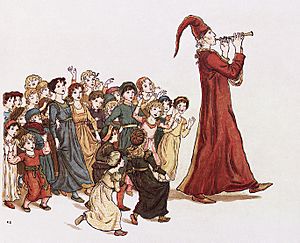
At the University of Marburg, the brothers saw culture as connected to language. They believed the purest cultural expression was in a language's grammar. They did not like how other writers changed folk tales from their original oral style to a more literary one. The brothers thought the style of the common people showed a natural, inspired poetry. They believed that this was different from artificially created "art poetry." As language and history experts, they looked into where stories came from. They tried to keep the original features of spoken language when writing them down.
The brothers strongly believed that national unity depended on knowing the cultural past. This past was shown in folklore. They worked to find and highlight a "Germanness" in the stories they collected. They thought folklore contained parts of myths and legends that were key to understanding German culture. By looking at culture through language, they wanted to connect German law, culture, and local beliefs.
The Grimms thought the tales came from traditional Germanic folklore. They believed this folklore had been "damaged" by later written traditions. When tales moved from spoken word to printed book, they were translated from local dialects to Standard German. But over many changes, the Grimms tried to bring back regional words and dialects to the tales. They wanted to bring back the language of the original spoken stories.
As early as 1812, they published a work about the two oldest German poems. These included a ninth-century heroic song.
Between 1816 and 1818, the brothers published a two-volume work called Deutsche Sagen (German Legends). It had 585 German legends. Jacob did most of the work collecting and editing these legends. He organized them by region and historical events. The brothers meant it as a scholarly work. But the historical legends were often taken from other sources, changed, and rewritten. Some experts criticized their method. However, their idea set an example for other legend collections across Europe. Unlike their folk tale collection, German Legends did not sell well. But it is a very important source for folklore experts.
Less known in English-speaking countries is the Grimms' important work on a German dictionary. They started the Deutsches Wörterbuch (German Dictionary) in 1838. They began publishing it in parts in 1852. They did not finish the dictionary in their lifetimes. This is because they included the history and analysis of each word.
Collaborative Works
- Die beiden ältesten deutschen Gedichte aus dem achten Jahrhundert: Das Lied von Hildebrand und Hadubrand und das Weißenbrunner Gebet, (The Two Oldest German Poems of the Eighth Century: The Song of Hildebrand and Hadubrand and the Wessobrunn Prayer)—published 1812
- Kinder- und Hausmärchen (Children's and Household Tales)—seven editions, between 1812 and 1857
- Altdeutsche Wälder (Old German Forests)—three volumes between 1813 and 1816
- Der arme Heinrich von Hartmann von der Aue (Poor Heinrich by Hartmann von der Aue)—1815
- Lieder der alten Edda (Songs from the Elder Edda)—1815
- Deutsche Sagen (German Sagas)—published in two parts between 1816 and 1818
- Irische Elfenmärchen—Grimms' translation of Thomas Crofton Croker's Fairy Legends and Traditions of the South of Ireland, 1826
- Deutsches Wörterbuch (German Dictionary)—32 volumes published between 1852 and 1960
Popular Adaptations
The following are adaptations from the work of the Brothers Grimm:
- Avengers Grimm, 2015 American film
- Grimm, 2011 fantasy crime television series about a Grimm descendant
- Once Upon a Time, American television series
- The 10th Kingdom, 2000 American television miniseries
- The Brothers Grimm, 2005 film starring Matt Damon and Heath Ledger
- The Wonderful World of the Brothers Grimm, 1962 film starring Lawrence Harvey and Walter Slezak
- Simsala Grimm, children television series
- A Tale Dark & Grimm, children's book by Adam Gidwitz
- The Family Guy episode entitled “Grimm Job” (Season 12, Episode 10), sees the show’s characters take on roles in three Grimm Brothers fairy tales: “Jack and the Beanstalk”, “Cinderella”, and “Little Red Riding Hood”.
See also
 In Spanish: Hermanos Grimm para niños
In Spanish: Hermanos Grimm para niños
- Grimm Family Tree
- Alexander Afanasyev
- Charles Perrault
- Giambattista Basile
- Norwegian Folktales
- Russian fairy tale


